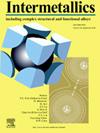The heterogeneity formation mechanism of twin wire-directed energy deposition-arc fabricated TiAl alloy
IF 4.3
2区 材料科学
Q2 CHEMISTRY, PHYSICAL
引用次数: 0
Abstract
Additive manufacturing (AM) has become an attractive method in fabricating TiAl alloys. In addition to the well-known anisotropy, additively manufactured TiAl alloys also exhibit heterogeneity. However, research in this area has been limited. This work systematically investigates the heterogeneity formation mechanism of the twin wire-directed energy deposition-arc produced TiAl alloy. The results show that the microstructure characteristics, such as the lamellar spacing (0.39 μm–0.56 μm), colony size (186 μm–232 μm), and α2 phase content (7 %–10 %), and microstructure degradation degree, present the tendency of increase from the upper to the lower part along the deposition direction, attributed to differences in the thermal cycle features experienced during AM. Consequently, its tensile strength (415.3 MPa–361 MPa) and elongation (0.54 %–0.38 %) also display a gradual decline from the upper to the lower part. This research contributes to a deeper understanding of the evolution of microstructure and the mechanical properties of additively manufactured TiAl alloys.
求助全文
约1分钟内获得全文
求助全文
来源期刊

Intermetallics
工程技术-材料科学:综合
CiteScore
7.80
自引率
9.10%
发文量
291
审稿时长
37 days
期刊介绍:
This journal is a platform for publishing innovative research and overviews for advancing our understanding of the structure, property, and functionality of complex metallic alloys, including intermetallics, metallic glasses, and high entropy alloys.
The journal reports the science and engineering of metallic materials in the following aspects:
Theories and experiments which address the relationship between property and structure in all length scales.
Physical modeling and numerical simulations which provide a comprehensive understanding of experimental observations.
Stimulated methodologies to characterize the structure and chemistry of materials that correlate the properties.
Technological applications resulting from the understanding of property-structure relationship in materials.
Novel and cutting-edge results warranting rapid communication.
The journal also publishes special issues on selected topics and overviews by invitation only.
 求助内容:
求助内容: 应助结果提醒方式:
应助结果提醒方式:


